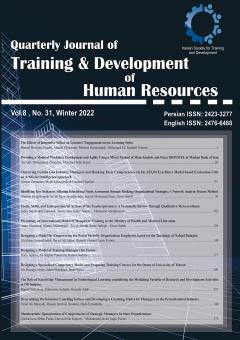-
-
List of Articles
-
Open Access Article
1 - Interactive video or video? Which one is more effective on learner engagement
Hamed Hoseini zarrabi Abasalt Khorasani Morteza Rezaeizadeh Mohammad ali Mazaheri -
Open Access Article
2 - Providing a Model of Workforce Development and Agility Using a Mixed Method of Meta-Analysis and Fuzzy DEMATEL in Maskan Bank of Iran
Ali Aali Mohammad Zia Al Dini mostafa hadavinejad -
Open Access Article
3 - Clustering Iranian Gas Industry Managers and Ranking Their Competencies via the EFQM Excellence Model-based Evaluation with an Artificial Intelligence Approach
Ali reza Zamanian Majid Jahangirfard Farshad Hajalian -
Open Access Article
4 - Identifying Key Indicators Affecting Educational Needs Assessment through Realizing Organizational Strategies: A Network Analysis Process Method
Ghasem Khajehvandi Seyed Reza Seyed Javadin Mojtaba Amiri Kavehmohammad Cyrus Naser Sharifi -
Open Access Article
5 - Traits, Skills, and Entrepreneurial Actions of the Teacherpreneurs: A Systematic Review through Qualitative Meta-synthesis
Zahra Sayehvand Farnoosh Alami Sara Salim Namin Mahmoud Abolghasemi -
Open Access Article
6 - Presenting an International Model of Manpower Training in the Ministry of Health and Medical Education
Aram Ghaniuon Ali Reza Afsharnejad Zeinolabedin Amini Sabegh Ehsan Sadeh -
Open Access Article
7 - Designing a Model for Empowering the Social Security Organization Employees based on the Teachings of Nahjul Balagha
Ali Akbar Esmaeilzadeh Seyed Ali Akbar Ahmadi Hamed FazliKebria -
Open Access Article
8 - Designing a Model of Training Managers for Future
Hoda Jajarmi Ali Asghar Pourezzat Kamal Dorrani -
Open Access Article
9 - Designing a Specialized Competency Model and proposing Training Courses for Deans of University of Tehran
Ali Bozorgi Amiri Zahra احتشام Iman Shokr -
Open Access Article
10 - Study of the role of knowledge management in technological learning by considering the mediating variable of R&D activities in the oil industry
Hamid Babadinia Tahmoores Sohrabi Hossain Adab -
Open Access Article
11 - Determining Performance Coaching Indices and Developing a Coaching Model for Managers in the Petrochemical Industry
Omid Ali Mashodi Hassan Darzian Rostami Hadi Zeraatpisheh -
Open Access Article
12 - Metaheuristic Optimization of Competencies of Strategic Managers in State Organizations
Gholamreza Abbaspasha davood kia kojoree Mohammad javad Taghipourian Gilani
-
The rights to this website are owned by the Raimag Press Management System.
Copyright © 2017-2026







